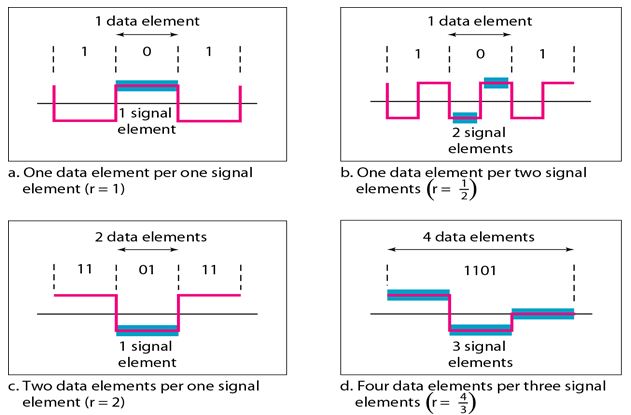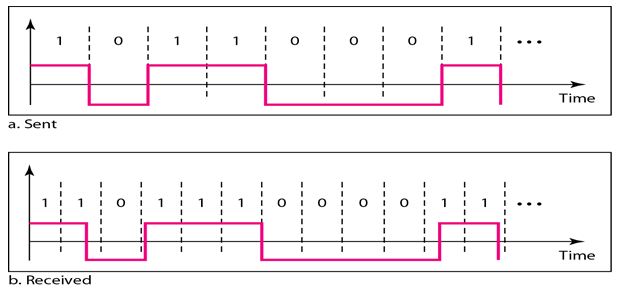Line Coding and Its Characteristics
Line coding is the process of converting digital data to digital signals.
The data may be in the form of text, numbers, graphical images, audio, or video, are stored in computer memory as sequences of bits.
Line coding converts a sequence of bits to a digital signal. At the sender, digital data are encoded into a digital signal; at the receiver, the digital data are recreated by decoding the digital signal.
Characteristics of Line coding
The different characteristics of Line Coding Technique are as follows:
1. Signal Element versus Data Element:
A data element is the smallest entity that can represent a piece of information. This is the bit. In digital data communications, a signal element carries data elements. A signal element is the shortest unit (time wise) of a digital signal. In other words, data elements are what we need to send; signal elements are what we can send. Data elements are being carried; signal elements are the carriers.
You May Also Like:
Different Line Coding Techniques
Different Block Coding Techniques
Different Scrambling Techniques
We define a ratio r which is the number of data elements carried by each signal element. The shows several situations with different values of r.
In part a of the figure, one data element is carried by one signal element (r = 1). In part b of the figure, we need two signal elements (two transitions) to carry each data element (r =1/2). In part c of the figure, a signal element carries two data elements (r = 2). In part d, a group of 4 bits is being carried by a group of three signal elements (r = 4/3). For every line coding scheme r value should be defined.

2. Data Rate versus Signal Rate:
The data rate defines the number of data elements (bits) sent in 1s. The unit is bits per second (bps). The signal rate is the number of signal elements sent in 1s. The unit is the baud. The data rate is sometimes called the bit rate; the signal rate is sometimes called the pulse rate, the modulation rate, or the baud rate.
One goal in data communications is to increase the data rate while decreasing the signal rate. Increasing the data rate increases the speed of transmission; decreasing the signal rate decreases the bandwidth requirement.
3. Bandwidth:
Digital signal that carries information is non-periodic. The bandwidth of a non-periodic signal is continuous with an infinite range. However, most digital signals we encounter in real life have a bandwidth with finite values. In other words, the bandwidth is theoretically infinite, but many of the components have such a small amplitude that they can be ignored. The effective bandwidth is finite.
4. Baseline Wandering:
In decoding a digital signal, the receiver calculates a running average of the received signal power. This average is called the baseline. The incoming signal power is evaluated against this baseline to determine the value of the data element. A long string of Os or 1s can cause a drift in the baseline (baseline wandering) and make it difficult for the receiver to decode correctly. A good line coding scheme needs to prevent baseline wandering.
5.DC Components:
When the voltage level in a digital signal is constant for a while, the spectrum creates very low frequencies (results of Fourier analysis). These frequencies around zero, called DC (direct-current) components, present problems for a system that cannot pass low frequencies or a system that uses electrical coupling (via a transformer).
6. Self-synchronization:
To correctly interpret the signals received from the sender, the receiver's bit intervals must correspond exactly to the sender's bit intervals. If the receiver clock is faster or slower, the bit intervals are not matched and the receiver might misinterpret the signals. The following figure represents the synchronization problem.

7. Built-in Error Detection:
It is desirable to have a built-in error-detecting capability in the generated code to detect some of or all the errors that occurred during transmission. Some encoding schemes that we will discuss have this capability to some extent.
8. Immunity to Noise and Interference:
Another desirable code characteristic is a code that is immune to noise and other interferences.
9. Complexity:
A complex scheme is more costly to implement than a simple one. For example, a scheme that uses four signal levels is more difficult to interpret than one that uses only two levels.
You May Also Like:
Analog to Digital Conversion Techniques
Different Transmission Modes
Back to DCN Questions and Answers

